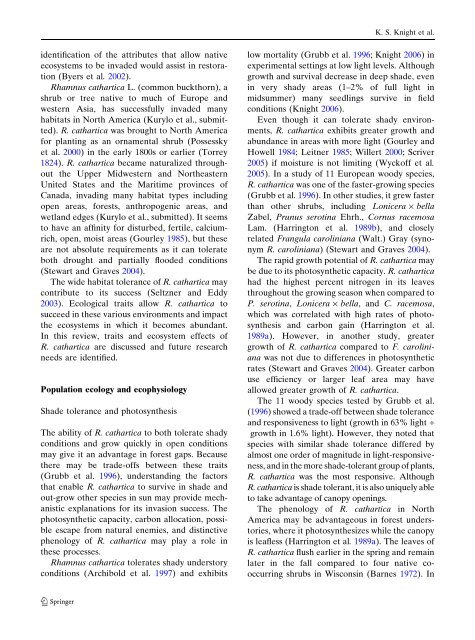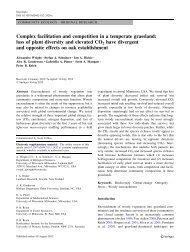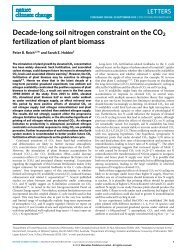Ecology and ecosystem impacts of Rhamnus cathartica
Ecology and ecosystem impacts of Rhamnus cathartica
Ecology and ecosystem impacts of Rhamnus cathartica
Create successful ePaper yourself
Turn your PDF publications into a flip-book with our unique Google optimized e-Paper software.
identification <strong>of</strong> the attributes that allow native<br />
<strong>ecosystem</strong>s to be invaded would assist in restoration<br />
(Byers et al. 2002).<br />
<strong>Rhamnus</strong> <strong>cathartica</strong> L. (common buckthorn), a<br />
shrub or tree native to much <strong>of</strong> Europe <strong>and</strong><br />
western Asia, has successfully invaded many<br />
habitats in North America (Kurylo et al., submitted).<br />
R. <strong>cathartica</strong> was brought to North America<br />
for planting as an ornamental shrub (Possessky<br />
et al. 2000) in the early 1800s or earlier (Torrey<br />
1824). R. <strong>cathartica</strong> became naturalized throughout<br />
the Upper Midwestern <strong>and</strong> Northeastern<br />
United States <strong>and</strong> the Maritime provinces <strong>of</strong><br />
Canada, invading many habitat types including<br />
open areas, forests, anthropogenic areas, <strong>and</strong><br />
wetl<strong>and</strong> edges (Kurylo et al., submitted). It seems<br />
to have an affinity for disturbed, fertile, calciumrich,<br />
open, moist areas (Gourley 1985), but these<br />
are not absolute requirements as it can tolerate<br />
both drought <strong>and</strong> partially flooded conditions<br />
(Stewart <strong>and</strong> Graves 2004).<br />
The wide habitat tolerance <strong>of</strong> R. <strong>cathartica</strong> may<br />
contribute to its success (Seltzner <strong>and</strong> Eddy<br />
2003). Ecological traits allow R. <strong>cathartica</strong> to<br />
succeed in these various environments <strong>and</strong> impact<br />
the <strong>ecosystem</strong>s in which it becomes abundant.<br />
In this review, traits <strong>and</strong> <strong>ecosystem</strong> effects <strong>of</strong><br />
R. <strong>cathartica</strong> are discussed <strong>and</strong> future research<br />
needs are identified.<br />
Population ecology <strong>and</strong> ecophysiology<br />
Shade tolerance <strong>and</strong> photosynthesis<br />
The ability <strong>of</strong> R. <strong>cathartica</strong> to both tolerate shady<br />
conditions <strong>and</strong> grow quickly in open conditions<br />
may give it an advantage in forest gaps. Because<br />
there may be trade-<strong>of</strong>fs between these traits<br />
(Grubb et al. 1996), underst<strong>and</strong>ing the factors<br />
that enable R. <strong>cathartica</strong> to survive in shade <strong>and</strong><br />
out-grow other species in sun may provide mechanistic<br />
explanations for its invasion success. The<br />
photosynthetic capacity, carbon allocation, possible<br />
escape from natural enemies, <strong>and</strong> distinctive<br />
phenology <strong>of</strong> R. <strong>cathartica</strong> may play a role in<br />
these processes.<br />
<strong>Rhamnus</strong> <strong>cathartica</strong> tolerates shady understory<br />
conditions (Archibold et al. 1997) <strong>and</strong> exhibits<br />
123<br />
K. S. Knight et al.<br />
low mortality (Grubb et al. 1996; Knight 2006) in<br />
experimental settings at low light levels. Although<br />
growth <strong>and</strong> survival decrease in deep shade, even<br />
in very shady areas (1–2% <strong>of</strong> full light in<br />
midsummer) many seedlings survive in field<br />
conditions (Knight 2006).<br />
Even though it can tolerate shady environments,<br />
R. <strong>cathartica</strong> exhibits greater growth <strong>and</strong><br />
abundance in areas with more light (Gourley <strong>and</strong><br />
Howell 1984; Leitner 1985; Willert 2000; Scriver<br />
2005) if moisture is not limiting (Wyck<strong>of</strong>f et al.<br />
2005). In a study <strong>of</strong> 11 European woody species,<br />
R. <strong>cathartica</strong> was one <strong>of</strong> the faster-growing species<br />
(Grubb et al. 1996). In other studies, it grew faster<br />
than other shrubs, including Lonicera · bella<br />
Zabel, Prunus serotina Ehrh., Cornus racemosa<br />
Lam. (Harrington et al. 1989b), <strong>and</strong> closely<br />
related Frangula caroliniana (Walt.) Gray (synonym<br />
R. caroliniana) (Stewart <strong>and</strong> Graves 2004).<br />
The rapid growth potential <strong>of</strong> R. <strong>cathartica</strong> may<br />
be due to its photosynthetic capacity. R. <strong>cathartica</strong><br />
had the highest percent nitrogen in its leaves<br />
throughout the growing season when compared to<br />
P. serotina, Lonicera · bella, <strong>and</strong> C. racemosa,<br />
which was correlated with high rates <strong>of</strong> photosynthesis<br />
<strong>and</strong> carbon gain (Harrington et al.<br />
1989a). However, in another study, greater<br />
growth <strong>of</strong> R. <strong>cathartica</strong> compared to F. caroliniana<br />
was not due to differences in photosynthetic<br />
rates (Stewart <strong>and</strong> Graves 2004). Greater carbon<br />
use efficiency or larger leaf area may have<br />
allowed greater growth <strong>of</strong> R. <strong>cathartica</strong>.<br />
The 11 woody species tested by Grubb et al.<br />
(1996) showed a trade-<strong>of</strong>f between shade tolerance<br />
<strong>and</strong> responsiveness to light (growth in 63% light ‚<br />
growth in 1.6% light). However, they noted that<br />
species with similar shade tolerance differed by<br />
almost one order <strong>of</strong> magnitude in light-responsiveness,<br />
<strong>and</strong> in the more shade-tolerant group <strong>of</strong> plants,<br />
R. <strong>cathartica</strong> was the most responsive. Although<br />
R. <strong>cathartica</strong> is shade tolerant, it is also uniquely able<br />
to take advantage <strong>of</strong> canopy openings.<br />
The phenology <strong>of</strong> R. <strong>cathartica</strong> in North<br />
America may be advantageous in forest understories,<br />
where it photosynthesizes while the canopy<br />
is leafless (Harrington et al. 1989a). The leaves <strong>of</strong><br />
R. <strong>cathartica</strong> flush earlier in the spring <strong>and</strong> remain<br />
later in the fall compared to four native cooccurring<br />
shrubs in Wisconsin (Barnes 1972). In






